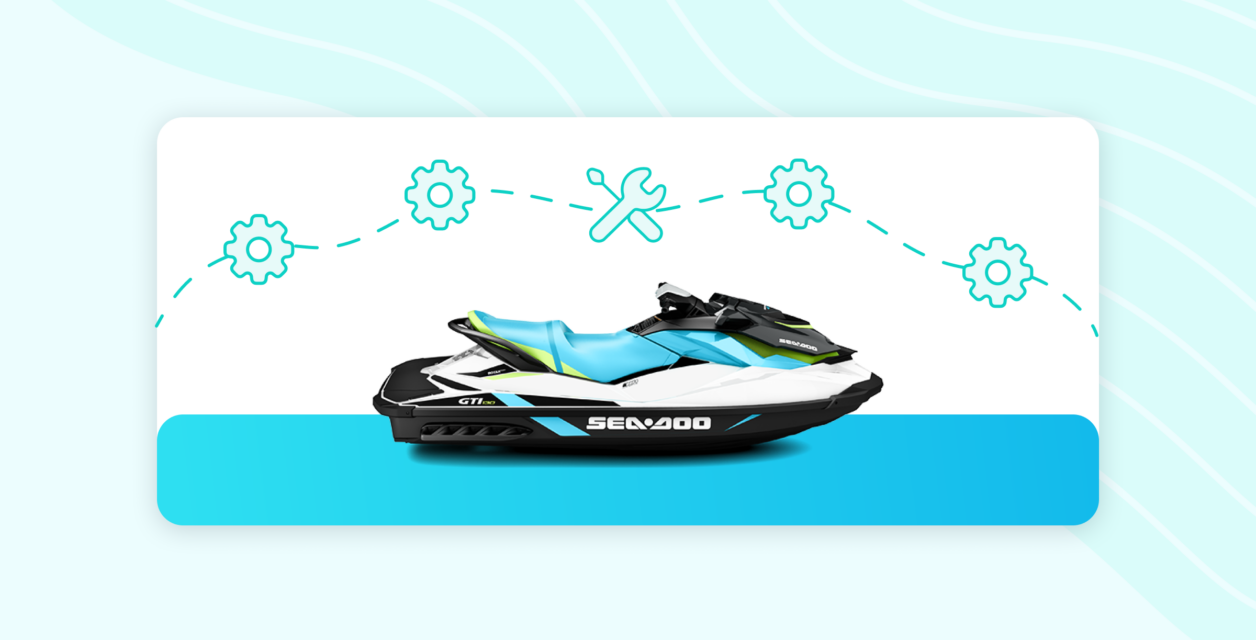Jet ski is part and parcel of running a jet ski rental business; that’s why you, as a watersports business owner, and your customers must make sure it’s treated with love. However, regular battery maintenance, proper PWC de-winterization, and a few things here and there would also last the ski’s life much longer. In this blog, we’re going to look into the additional five common issues watersport operators face during business operations. Tired of checking the old forums for answers? Look no further! :)
In the previous blog of the series, we have already discussed some common types of jet ski damage with potential solutions, so if the last guide didn’t help, then you’re in the right spot. ;)
#1: Storage Compartment Doesn’t Close or Is Unstable
While it might seem like something to be fixed at a low priority, the compartment door actually plays a crucial role in saving your customers’ belongings. Many tour operators don’t have a physical location, so their customers must rely on a jet ski’s storage space — front access storage (a.k.a. front hatch), Glovebox, and under the seat in some models. It’s unnecessary to reach high speeds on equipment for a compartment door to open accidentally during the ride, as choppy waters may just do the trick, which can also flip the WaveRunner. Here’s your checklist for making sure your PWC’s compartment door is suitable for starting a rent time or a jet ski tour:
- Close the compartment doors and hear the sound confirming that they’re closed.
- Check the doors for stability, and lack of backlash and gaps.
- Give your ski a test run to make sure nothing gets lost from storage space, and flip the equipment for the same check.
Without paying proper attention to this issue, your customers can lose their belongings, and, as a result, you may get a bad online review or even a financial dispute at the worst…
#2: Jet Ski Doesn’t Go as Fast as Used to
Not to be confused with PWC not starting at all, this scenario description applies to the skis that noticeably go slower than they used to. Over time, you want to look into your equipment inventory, especially if you’ve been running your watersport business for multiple seasons, and jet ski’s speed is definitely one of the aspects to check on. As with other common jet ski issues, there could be various reasons for your WaveRunner to reduce the speed:
- Something stuck in the pump if the following occurs:
- Vibration
- Sluggishness
- Lack of Acceleration
- Impeller has worn down blades — likely will need swapping.
- PWC bogs down.
#3: Issues with Acceleration
Similar to the jet ski losing speed, acceleration issues can ruin fun time on the water for your customers, which is why it’s important to address it before the issue gets noticed by your guests. Usually, when it comes to dealing with rather technical stuff, such as your PWC’s acceleration, we recommend taking it to a mechanic, but here are some things you can check on before hitting them up:
- If it vibrates during acceleration — check the pump, as it can be connected to WaveRunner’s issues with speed.
- Your jet ski sucked up a rope or sucked in some sand.
- Incorrect oil level — see if overheating alarm is on.
If your watercraft is smoking, then it’s a completely different story but can still be potentially managed.
#4: Water Leak
First and foremost, if you notice a water leak, stop renting this jet ski to your customers immediately, as it’s not safe to operate leaking equipment. WaveRez makes it easy to manage your equipment availability so that you don’t get new bookings for PWC that needs to be fixed. Schedule your free demo session with our sales team, or drop us a line today to learn more about how WaveRez can help you grow your jet ski rental business. Now, let’s get back to what you need to look for if you see the leak.
Be sure first to hop off your jet ski, turn the engine off, and put the watercraft on the trailer before doing the following:
- Drain your jet ski.
- Grab the flashlight and check the following common parts for watercraft leakage:
- Intermediate shaft
- Midshaft hose
- Coupler
- Flush hose
- You can also put water in the hull and tip the ski to discover all your leakage areas.
A typical reason for water to leak in a jet ski can be connected to the following:
- Hole in the exhaust hose
- Broken hose
- Loose hose connection
Failure to take proper care can cause issues with acceleration and PWC going slower, so it’s better to fix the problem sooner rather than later.
#5: Misfired Engine
Finally, the misfired engine can be related to several issues that we have already discussed in this post, including water leaks and problems with acceleration. If neither of these seemed to be the cause, then here’re some parts that you can try replacing before looking into replacing the engine itself:
- Fouled / defective / worn spark plugs
- Faulty ignition coil
- Clogged injectors
If your engine doesn’t work the way it should, it may eventually come to the point where your jet ski or WaveRunner won’t start, so you always want to maintain a WaveRunner or jet ski to keep it lasting for years.
Bonus: More Reasons for PWC Overheating Alarm
Lastly, if you really want to go above and beyond about your jet ski maintenance and think that the watercraft’s overheating alarm is on for a different reason, then here are a few more potential reasons:
Low oil — sometimes, replacing the oil filter or checking the whole injection system is unnecessary despite our recommendation in the previous guide, as you may simply need to refill the oil.
Waterflow clogged; here’s how to locate the clog:
- Clear the intake grate.
- Look at the connection where the flush connects to the engine.
- Check the smaller hoses that come from the read of the manifold.
- Disconnect the hoses and blow through them to make sure they are clear.
Turn the engine off for a couple of minutes and let it cool; flush the engine if back to your business location.
Conclusion
This guide is based on the most pressing issues that watersport operators renting jet skis to customers face on a daily basis. Many jet ski tour operators claim that guest satisfaction is their utmost priority and, to make sure their fun time on water doesn’t get ruined, your equipment needs to be carefully looked after. As with our other guides, we always recommend checking your jet ski manual for more precise info specific to your PWC’s model and make. Have anything to add? Drop your thoughts in the comment section below! We’d love to hear from you and be committed to providing you with resources that can help you grow your watersport business. 😉



